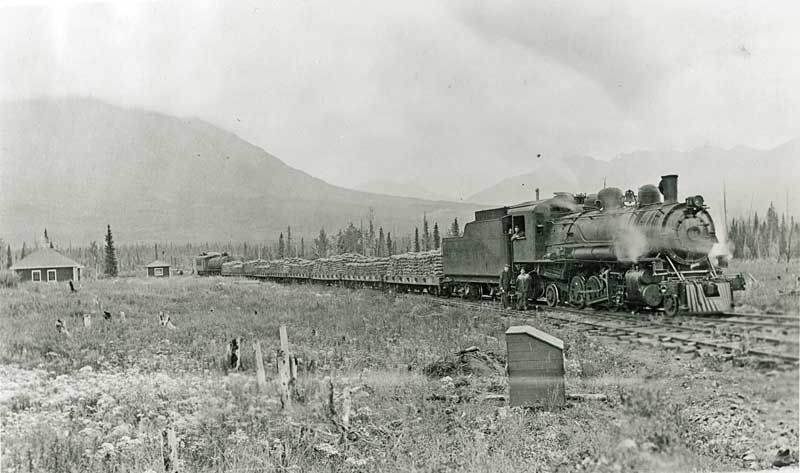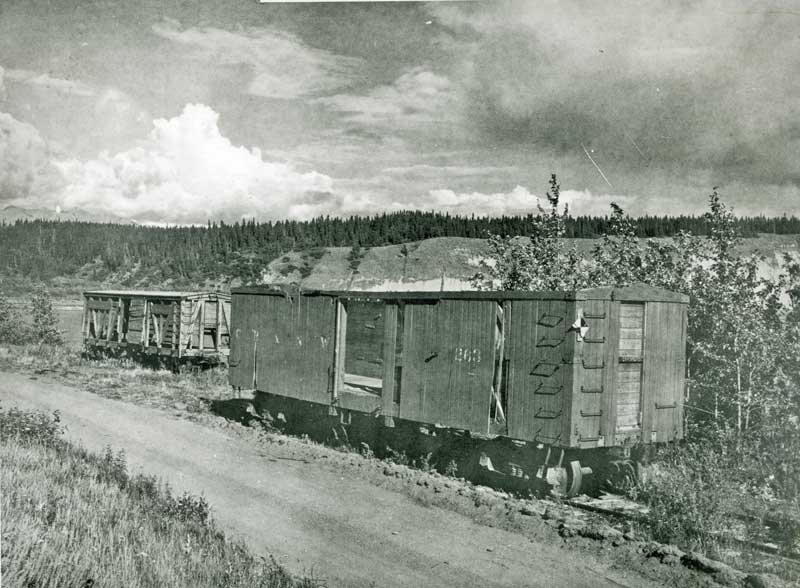Life at Kennecott went on as usual, but development of the mill site ended in 1923 with the addition of the water flotation plant to enhance an enlarged ammonia treatment system. It was a final piece in a master plan developed by E.T. Stannard years before to effectively process the carbonate ore, which could not be mechanically separated. The installation of these two complementary processes marked a huge step foreword in copper milling efficiency. The final great improvement was completed at the height of production, one year before Stephen Birch’s final visit. Except for the re-building of the destroyed power plant and the addition to the hospital, the mill addition was the last major work ever done at Kennecott.
Up on the ridge, Superintendent Douglass had been developing the Glacier Mine. It was separate from the underground mine system, being primarily an open-pit mine. In 1920 the company built the 5,000-foot-long tram, extending from Jumbo tram station no. three in an easterly direction up to the rock glacier. The mine was a rock glacier consisting of ice mixed with talus containing dolomite limestone and the eroded part of the original Bonanza ore outcropping. Until 1920 the company had been too busy developing high-grade ore veins. Finally the company turned its attention to the surface ore found not only at the rock glacier, but also on the extensive Bonanza talus slide directly below the upper camp.
 |
| The abandoned mill in 1950 --Charlie Ricci photo |
The Glacier Mine and the Bonanza slide ore was heavily mixed with waste rock and was too lean to process as long as there was an abundant supply of high-grade copper. But those days were soon over. The average content of the high grade ore slipped from seventy percent to about fifty percent by the early 1920s.
Thus the extraction of ores of lesser values began. The expansion of the ammonia leaching plant and the building of the water flotation system allowed for the expanded processing of these lower-value carbonate ores, extending the life of the mine by several years. Yet in the end, even the ammonia leaching plant became too expensive to operate. By then all resources had been placed into the extraction of the remaining floors and pillars--the last of the high-grade ore along the fifty-two miles of underground workings within Bonanza Ridge.
Even while Kennecott committed more money into the milling process to extend the life of the mines, the massive rich ore stopes had already been largely cleaned out. The Bonanza and Jumbo mines were considered to be mature mines. Most of the effort in these areas was concentrated on the extraction of the rich pillars still left in place to keep each level intact. The process of pillar extraction was necessarily left to the the very end, as the removal of pillars meant the collapse of various levels. There were about a dozen levels in Jumbo and Bonanza that would be affected by this process. This final step could only be initiated once the engineers determined that there was nothing left to mine. A carefully laid-out plan of retreat specified the order of removal of the ore pillars so that mining could be conducted safely and without mixing high amounts of useless waste ore in with the remaining high-grade ore of the pillars and floors.
Finally, Alan Bateman marked out two large areas for exploratory drilling, drifting and cross-cutting in the late 1920s. This was in the large block of unexplored ground between the Jumbo and the Erie.
With the opening of the Jumbo 1500 level crosscut tunnel connecting Erie to Jumbo, four small ore bodies were discovered. This ore, along with that from the northerly Erie Mine, was hauled up the Jumbo incline so it could be transported to the mill on the Jumbo tram. Although Erie had produced ore in small quantities since 1916, this was the first time that full production was possible. The Erie barracks was expanded in 1924 to take advantage of this development. Most of the new exploration from the Jumbo was now directed toward Erie. A long crosscut parallel to the 1,500 level Jumbo one was completed in 1930 from the 2,600 level of Mother Lode to the 1,050 level of Erie, crossing the 2,500 level of Jumbo, which became the deepest point of the Jumbo thirty-degree incline. Much to the frustration of the engineers, the entire four-mile run proved barren, finally proving that the lower levels of the copper ore veins had already been reached. Alan Bateman then convinced Kennecott to run another exploratory cross-cut tunnel northward from the 700 level of the Jumbo incline toward Erie--well above the main cross-cut. Bateman was convinced that ore had to lie at this level, but his project was quietly abandoned when the tunnel encountered difficulties as it approached the overhead Amazon Glacier in 1937. It was Alan Bateman’s last hope and his greatest disappointment. Cross-cut 710 North was the last long exploratory tunnel ever run by Kennecott.
 |
| A CRNW ore train passes Chokosna in the late 1930s |
On the Bonanza side, all the activity remained centered at Mother Lode, which was the deep extension of the Bonanza-Mother Lode orebody. The Bonanza incline which led to the 1,257 crosscut over to the Mother Lode incline remained in heavy use because it was the primary route for tramming the Mother Lode ore to the surface. The 800 level cross-cut, 450 feet above the newer cross-cut that connected directly into the Mother Lode incline shaft was last used to complete the exploration of the Marvelous ore bodies in 1927. The upper 1,200 vertical feet in the Bonanza was almost completely absent of activity while the Mother Lode 1,252 stope and other Mother Lode stopes adjacent to and below the Bonanza property continued to operate at a furious pace.
Although the engineers had concluded that the likelihood of finding additional rich ore bodies was remote, the company continued to drive the Mother Lode incline deeper, extending it well beyond the 1,600 level where the last major orebody had been located. Even with the failure of the 2,500 level cross-cut to produce new ore bodies, the engineers chose to continue the Mother Lode incline all the way to the 2,800 level. Nothing of interest was found anywhere in the last thousand vertical feet. That was the end of it.
As underground exploration expanded, production rapidly declined. The slump began to be reflected in the operation of the railroad. The CRNW quietly dropped daily service in the mid-1920s. Near-impossible conditions produced maintenance problems far exceeding anything encountered in the States. It earned the CR and NW the nickname “Can’t Run and Never Will.” Lapses in the schedule had long been accepted as normal. The ending of the daily train service went almost unnoticed. Soon the typical line of thirty-five flat cars became thirty, then twenty. A run of thirty cars every other day became the norm, then even that diminished sharply as the 1920s came to an end.
In 1924 the two-story Dwyers Inn at Strelna burned down, never to be replaced. Strelna, once considered the future hub for a mining district which contained the promising North Midas and Elliot-Hubbard Mines on the upper Kuskulana, was relegated to just another whistle-stop. These mines and most the others closed by the end of the 1920s. Early proposals to run branch lines up the Kuskulana and McCarthy Creek never even made the drawing board.
Traffic through McCarthy had begun to slow as the Chisana gold boom quickly became a bust. The other Nizina gold field operations continued, but they employed relatively few men. The Green Butte closed in 1925, and the road up McCarthy Creek was abandoned. McCarthy awaited an end that would shared with Kennecott. Chisana, Strelna, Chokosna, Chitina and Bremner never developed into the mining hubs that once seemed inevitable.
Traffic through Chitina had slowed to a crawl as freight and passengers from the Alaska Steamship Line developed a preference for Seward over Cordova, and for the new Alaska Railroad over the Copper River and Northwestern, which ended at Chitina instead of Fairbanks. Passengers arriving there found a rough wagon trail of 350 more miles if they wanted to reach Fairbanks. The surveyed route extending the Cordova Mainline from Chitina to Fairbanks became a historic footnote in 1914. The Hotel Chitina, which had been optimistically expanded to seventy rooms by 1917, became an early relic of a boom that had busted. All that remained was the business of the Kennecott copper mine itself. In 1924 it was not yet evident to many that a precipitous decline culminating in a full shut down had already begun.
 |
| Abandoned boxcars on Kotsina Hill east of Chitina --UAF Archives Continue with Chapter 45: "The Marvelous Assignment" |
No comments:
Post a Comment